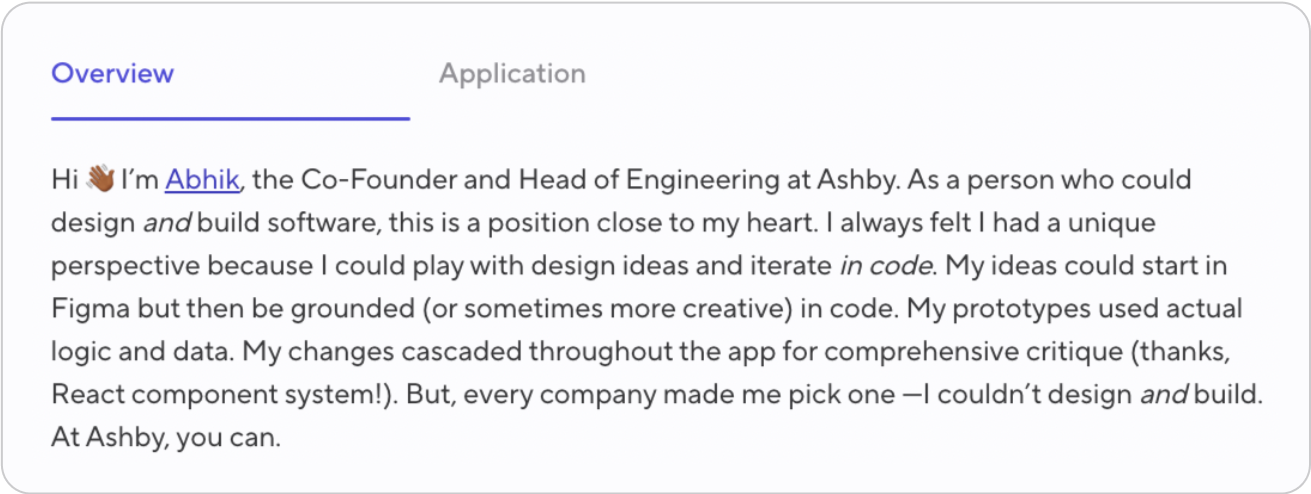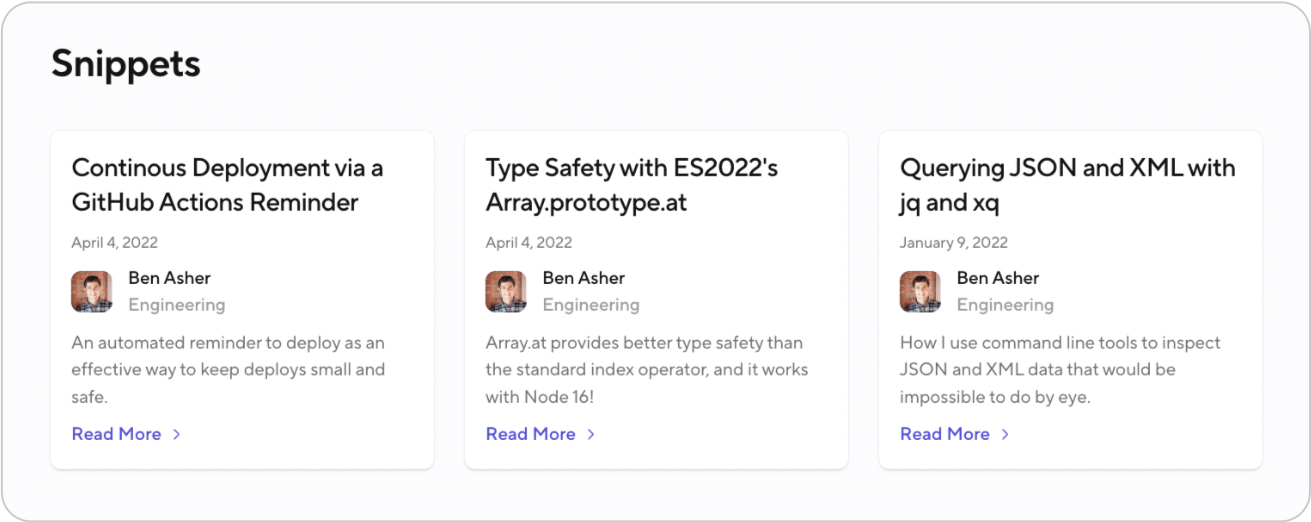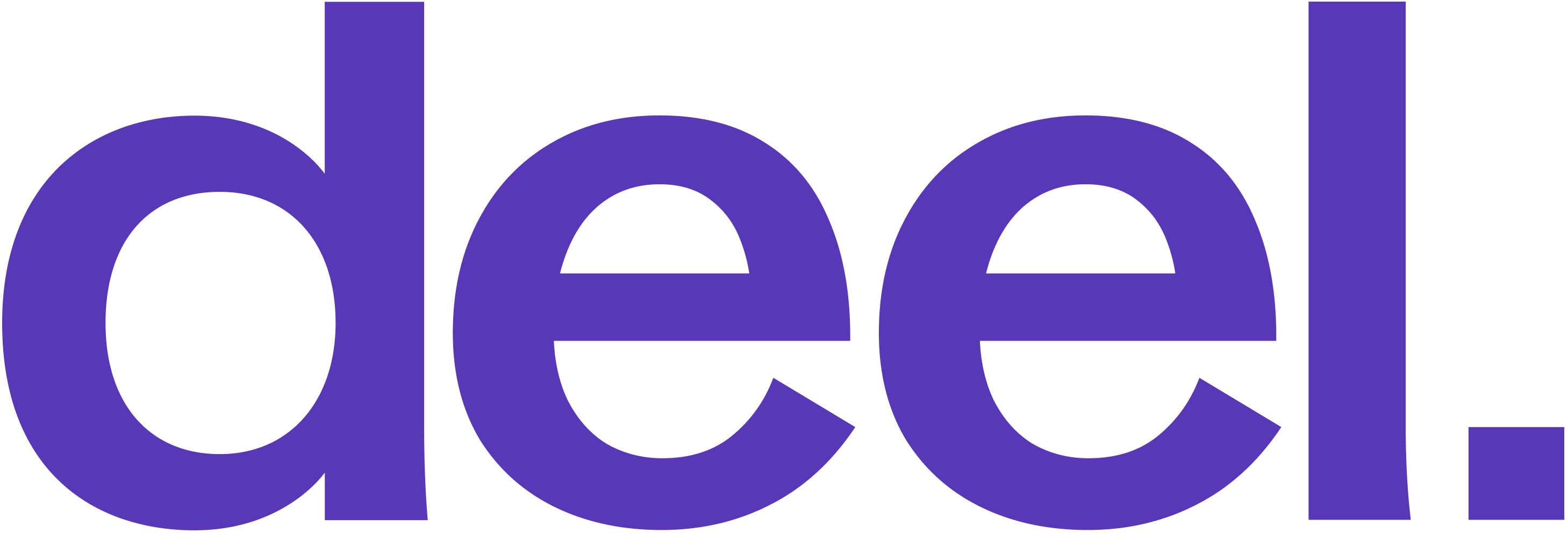Career Pages | Building Your Employer Brand to Attract the Right Candidates
10 minute read
Hiring top-tier engineers is one of the biggest challenges in my role as Ashby’s VP of Engineering. I’ve learned that your careers page - and, more broadly, the way you optimize your website with recruiting in mind - is one of the biggest keys to finding the talent you want.
What can a job description say?
Ashby was in stealth for a long time, and we had to put a lot of effort into our careers pages because people didn’t know who we were. Aside from the careers page, what else could I tell them about the company before they spoke with me?
I came up with the idea of using our job descriptions to tell a story.
Every company has some type of role they're thinking about differently than other companies. The first consideration in the job description was how to communicate what makes each role unique. Most candidates half-ignore job descriptions. I thought, “If they're going to read it, I might as well make it something different.” Rather than list requirements and responsibilities, consider: what makes your company and the roles you're designing special?
The second piece is your manager. Your manager makes a huge difference in your job. I wanted to see how to infuse that into job descriptions. How can people figure out who I am and what I'm about?
One of Ashby’s engineers, Ben, followed Ashby’s co-founder, Benji, from their previous company. Ben felt that Benji spoke passionately about engineering management. Ben said that most managers felt like they fell into the role, whereas Benji felt like he wanted to change the game when it came to engineering management.
I wanted to find a way to capture that feeling and communicate that leadership strength from the very first contact with a potential applicant. From there I decided to write the descriptions in first person rather than write it as if I'm some corporate entity trying to explain the basics of the job.

I don’t want people to feel like another cog in the wheel at Ashby. I want people to feel the excitement that we have about our work and see the actual projects they would do rather than abstract responsibilities. The career page and the job descriptions are an important piece of that.
Simplicity and using the default structure is your enemy in creating powerful job descriptions and a powerful career page. If you say you need four years of software engineering experience, that doesn't tell anyone what type of experience you're looking for. Instead, think about what you want people to be excited about in the role. Be opinionated so that you'll attract the people who are on board with the way you want the role to work.
What are candidates looking for, and what are they taking away?
Once you have your job descriptions worked into a form that you like, you’ll find that a lot of the heavy lifting on your careers page itself is handled. From there, you can expand your focus outward to different areas, but you should keep the candidate at the front of your mind as you do.
What are great candidates looking for when they view your career page? When a candidate comes to your careers page, they're trying to understand a couple of things:
- Is this something I would want to work on?
- Is this a team that I want to work with?
- Is this a manager that I want to work for?
- Is this a set of leaders that I want to work for?
- Does this fit my style of work?
- Are these the benefits that I'm looking for?
It’s really just a few big concerns. They want a sense of what the job is, they want a sense of what they’ll gain by working with you, and they want a sense of who your company really is.
Use your careers page to try to answer as many of these concerns as you can as quickly as you can. A lot of job candidates go through the entire recruiting process, really enjoy the company, and then get an offer that doesn't match the band that they're looking for. Or their potential manager's working style isn't a fit. They realize they've wasted so much time. As a company, the more you can pull those questions up front, the more candidates are going to be willing to engage with you. We also use candidate surveys to understand what went wrong and ensure we work that into optimization of our site.
And the more important a concept is to your company, the sooner you should communicate it.
Not every engineer cares about the way they work. They may be very mission-oriented and want to go save the world. That’s fantastic, but that's not Ashby. While we’re not saving the world, we are building a company that cares deeply about its customers and executes exceptionally at making their lives better, and we put a lot of effort into doing that. And we know there are other people out there whose primary goal is to build fantastic software. So that was the perspective we went to, instead of claiming to be something we're not.
On the other hand, if you're a very mission-driven company, you need to lean into it. Focus on communicating how you're accomplishing your mission and why you're going to be the ones that solve it. It boils down to goals.
Short form content wins
If you want an excellent careers page: drop the idea of a single page. The way I think about it is less about a careers page and more about holistic recruiting marketing. People will stumble upon your website through many different avenues. How is the candidate going through your website to understand more about the company?
When a candidate finds out about you, how will they then navigate to all the content that you want them to read? At Ashby, we wanted to have a steady stream of content about our culture, and we think of that as being under the umbrella of a careers page.
As an engineer, I would search for questions relevant to my work and then stumble on personal blogs of engineers who had answers. I wanted to replicate that with our blog. People need to find you. They're not going to go looking for a stealth company by name. But what they are going to do is search for things that are related to their work. And that's where our most viewed form of content came in: snippets, found at the bottom of our Engineering blog, are small bits of things we’ve learned that are helpful in our day to day work. Short form content helps you connect with the outside world.

Every channel of communication you use, from social media to paid ads to your landing pages, should work for both your customer and your applicant.
Other pages to optimize with hiring in mind
Think about where else your website can be optimized for your applicants.
For instance, a lot of small companies start with a team page, but just as quickly stop showcasing it. And then they show their executive team, maybe like one or two people as profiles. But I think your team page is actually super, super powerful. These are the people applicants are going to work with — why not share who they are?
Candidates don’t meet the team right away, but they want to know your team. So I thought it would be really nice to have the entire team just sitting there, available for you to get to know them a little bit more. And it's been huge. Not only do people really read it, they come into our interviews and ask the team questions about their pages. Our team is then answering those questions deeply. It’s wonderful sharing.
What the team does is impressive, so why not show it off?
Another element to seriously consider is your values.
Be opinionated. If you present a set of values like every other company is presenting, you don't differentiate yourself. Instead, think about what makes you different than every other company out there. That could be your mission, the way you work, or something else, but it's what makes your company unique.
One value might be your DEI initiatives. DEI is important to Ashby, and I wrote as much in our job descriptions. I wrote it from a kind of a personal perspective in the style of our job descriptions. Simply including that note has stood out to people from underrepresented groups who are reading these listings, and I do hear it a lot when I talk to candidates. You need to really call DEI out on your career pages if it's important to you.
You also need to avoid platitudes. If your values are to “be kind to each other,” know that everyone says that. What people care about is how you’re actually making that value a reality.
Our thoughtful communication is a good example of that. A lot of candidates have commented that it's actually more powerful than a set of values to them. While we haven't articulated all our values, one of our core values is excellent communication, and that comes through. A lot of companies can say that, but in that article we show candidates how we accomplish it.
Measuring success
When it comes to measuring success, I suggest you track a few metrics:
- How many visitors are you getting and who are they? Here I look for top performing blog posts, understand who is viewing them and then think about other related topics we could expand on.
- What are your conversions to final rounds? If someone sees a job description, are they actually applying? Are the candidates applying high quality? If you build all this content, you still have to distribute it, so you want to see what distribution channels are creating quality conversions.
- What are people actually reading? How many people actually get from the top of my page all the way to the bottom? If they stop halfway, then I’ll either condense it or switch the content around, because you want people to read it end to end.
- What are your paid ad metrics? We've tried Twitter ads before for our job descriptions. We didn't get as much lift as we would like, but we wanted to see how many people would convert from that.
Treat your careers page like a product. It isn’t enough to measure your wins and call it a day. There are many things that adversely impact otherwise great career pages.
Your listings aren’t for everyone - and that’s good
The fear that you have of being opinionated is that you’ll turn people off. And our opinionated content has turned people off. It’s a good thing. I start my email outreach by sharing our article on how we communicate. Some people love that, but some people find that isn't for them. And that's totally fine, I don't argue. Articles like that are there to help people understand who we are as a culture and how we approach engineering.
The people who aren’t a fit will eventually figure it out. And for us that was through the interview process. I would take the first call and then we'd talk about it and they might say, “Oh, you don't use Slack? This is not a fit.” I'd just wasted thirty minutes of my time and the candidate’s time taking this call.
So it's best to put those differences upfront in order to save your team, your team's time, and the candidates' time.
Creating career page excellence
The career pages that stick out to me are the ones that are transparent. But PostHog is a notable exception. Our team spent some time with Cory Watilo, Lead Designer at PostHog to talk about how they approached it.
Their career page has a unique, customized feel that makes it stand out. Every element was designed around the natural flow a candidate would take as they explored the page. Every element is intentional - and communicates either something about PostHog’s culture or something that candidates would want to know about the job.
Cory used Ashby’s API to build and host their careers page, inserting fun moments that, in his words, “spark joy,” like a count of who on the team prefers pineapple on pizza and a spray of digital confetti when you submit an application. PostHog is doing things no other company is trying, and it shows.
Download this PDF to see an in-depth guide of what Cory’s design choices were, and what you should think about when using Ashby’s API to design your own careers page.


